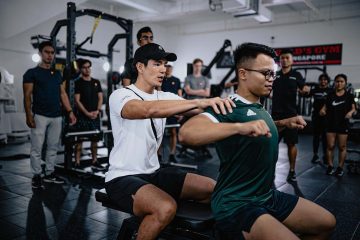HIIT for Beginners: Your First 4 Weeks to a Fitter You

Starting a new fitness journey can feel overwhelming — especially when you’re juggling work, family, and other commitments in a fast-moving city like Singapore. Many first-timers are drawn to fitness HIIT training because of its short duration and effective results. But is it suitable for beginners? Absolutely.
High-Intensity Interval Training (HIIT) might sound intimidating, but it can be customised for all fitness levels — including complete beginners. With the right approach, it’s possible to ease into HIIT gradually, safely, and effectively.
If you’ve been meaning to get fitter but haven’t known where to start, this article breaks down a 4-week beginner-friendly HIIT plan tailored for the average Singaporean lifestyle.
Why Beginners Should Consider HIIT
Many people assume that HIIT is only for experienced athletes or gym regulars, but the truth is, HIIT is one of the most flexible workout styles available. You don’t need expensive equipment or a big space, and sessions can be completed in under 30 minutes — making it ideal for those starting out.
Here’s why HIIT works well for beginners:
- Time-saving: A great option for those with packed schedules
- No equipment needed: Most beginner routines use bodyweight exercises
- Easy to adapt: Movements and rest times can be modified to match your fitness level
- Progressive results: You’ll feel stronger and more energetic within weeks
With proper planning and a gradual build-up, HIIT can be both beginner-friendly and highly effective.
The 4-Week Beginner HIIT Blueprint
This plan is structured to guide complete novices through increasing levels of intensity, while also keeping it realistic for someone in Singapore who may be balancing work, family, and unpredictable MRT delays.
General Tips Before Starting:
- Always warm up for 3–5 minutes with dynamic stretches or light cardio (e.g., arm swings, marching in place)
- Cool down after each session with stretching, especially for your hamstrings, quads, and shoulders
- Hydrate properly, especially if doing your workout indoors with no fan or air-con
Week 1: Get Moving, Get Familiar
Focus: Learn basic movements and develop consistency
Frequency: 3 sessions/week
Time: 15–20 minutes/session
Workout structure:
- 20 sec squats → 20 sec rest
- 20 sec high knees (low impact) → 20 sec rest
- 20 sec push-ups (knees or wall) → 20 sec rest
- 20 sec shoulder taps → 20 sec rest
Repeat the entire set 3 times
Goal: Build comfort with movement and finish each session without skipping rounds
Week 2: Build Confidence and Stamina
Focus: Slightly increase intensity and session duration
Frequency: 3–4 sessions/week
Time: 20–25 minutes/session
Workout structure:
- 30 sec jumping jacks → 15 sec rest
- 30 sec reverse lunges (alternating legs) → 15 sec rest
- 30 sec incline push-ups (on a table) → 15 sec rest
- 30 sec leg raises → 15 sec rest
Repeat for 3–4 rounds
Goal: Improve stamina, handle reduced rest time, and learn better control
Week 3: Add Variety and Challenge
Focus: Engage more muscle groups and raise heart rate
Frequency: 4 sessions/week
Time: 25–30 minutes/session
Workout structure:
- 40 sec bodyweight squats → 20 sec rest
- 40 sec mountain climbers (slowed pace) → 20 sec rest
- 40 sec triceps dips (using a sturdy chair) → 20 sec rest
- 40 sec slow burpees (skip the jump if needed) → 20 sec rest
Repeat 3 rounds
Goal: Increase movement variety, build core and arm strength
Week 4: Test Yourself and Stay Consistent
Focus: Push your limits within your comfort zone
Frequency: 4–5 sessions/week
Time: 30 minutes/session
Workout structure:
- 30 sec squat jumps → 15 sec rest
- 30 sec plank to push-up → 15 sec rest
- 30 sec alternating side lunges → 15 sec rest
- 30 sec fast feet (run in place) → 15 sec rest
Repeat 4 rounds
Goal: Test how far you’ve come, measure your performance, and reflect on energy, confidence, and movement control
Local-Friendly Adjustments for Singapore Homes
Singaporeans often live in HDBs or condos with limited space, but that doesn’t mean you can’t make it work.
Here’s how to adapt:
- Use yoga mats to cushion and protect flooring
- Choose low-impact versions of high-intensity moves to reduce noise
- Stick to vertical motion exercises like high knees or squat pulses
- Schedule workouts at appropriate times to avoid disturbing neighbours
Tracking Progress Beyond the Scale
A common beginner mistake is relying too heavily on the weighing scale. Instead, consider these better indicators of progress:
- You can complete more reps than before
- Your rest heart rate is gradually lowering
- You feel more alert during the day
- Clothes fit better and you feel leaner
- You’re less breathless walking up MRT stairs
Fitness is about performance, energy, and how you feel — not just the numbers.
Staying Motivated During Your First Month
Starting anything new comes with ups and downs. Here are some Singapore-specific motivators to keep you going:
- Join a community class: Meeting others helps you stay accountable
- Mark your calendar: Treat workouts like important appointments
- Reward yourself: After finishing a tough session, treat yourself to a fresh coconut or smoothie
- Remind yourself of your ‘why’: Whether it’s climbing Bukit Timah Hill with ease or playing with your kids without getting tired
For those who prefer structured guidance or variety, local gyms such as TFX provide beginner-friendly HIIT classes that ensure you’re progressing safely and effectively.
FAQ
Q: I’ve never worked out before. Is HIIT too intense for me?
A: Not at all. HIIT can be scaled to match your current ability. Start with basic moves, longer rest times, and fewer rounds. Your body will adapt quickly with consistent effort.
Q: How long will it take before I see results?
A: Most beginners notice improvements in stamina, mood, and strength within 2–4 weeks. Fat loss and muscle tone may take slightly longer depending on diet and sleep habits.
Q: Can I do HIIT daily?
A: For beginners, 3 to 5 times a week is ideal. Your body needs rest days to repair and grow stronger, especially in the first month.
Q: What if I get sore after workouts?
A: Some soreness is normal as your muscles adjust. Stay hydrated, stretch well, and get adequate rest. Over time, your body will recover faster.
Q: Do I need any equipment to follow this 4-week plan?
A: No equipment is required. However, you can add light weights or resistance bands in the future to increase difficulty as you progress.










